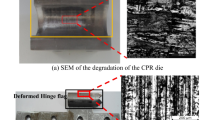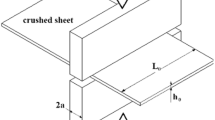Abstract
In general, the contact conditions between the tool and the workpiece materials in sheet metal forming process are always of high industrial importance since it permits to enhance the tool life. The present work focuses on the sliding metallic contacts taking place in the case of the manufacturing of hinges. A case study has been conducted on the cold plastic rolling (CPR) tool and the hinges in the CPR process. An expertise of CPR die active part and hinge surface was carried out in order to identify and to analyze the failure mechanisms. Several techniques were used such as profilometry, energy dispersive spectroscopy (EDS), optical and scanning electron microscopy (SEM). The failure mechanisms of the tool and the hinge were studied during various cycles of manufacturing. The failure of the CPR die active part was found to be related to the transfer of fragments from the hinge material and then their accumulation on the tool surface, generally referred to galling. The failure mechanisms of the hinge material were found to depend on the number of manufacturing cycles. At first and intermediate stages, fine and large scratchings were produced on the curved surface of the hinge, respectively. At later stages, a back transfer of sheet fragments to the hinge surface takes place by severe scratchings.
Similar content being viewed by others
References
Findik F (2014) Latest progress on tribological properties of industrial materials. Mater Des 57:218–244
Schedin E, Lehtinen B (1993) Galling mechanisms in lubricated systems: a study of sheet metal forming. Wear 170(1):119–130
Van der Heide E, Schipper DJ (2003) Galling initiation due to frictional Heating. Wear 254(11):1127–1133
Boher C, Attaf D, Penazzi L, Levaillant C (2005) Wear behaviour on the radius portion of a die in deepdrawing: identification, localisation and evolution of the surface damage. Wear 259(7–12):1097–1108
Vitos L, Larsson K, Johansson B, Hanson M, Hogmark S (2006) An atomistic approach to the initiation mechanism of galling. Comput Mater Sci 37:193–197
De Rooij MB (1998) Tribological aspects of unlubricated deepdrawing processes. University of Twente, Twente
Hirasaka M, Nishimura H (1994) Effects of the surface micro-geometry of steel sheets on galling behavior. J Mater Process Technol 47:153–166
Podgornik B, Hogmark S (2006) Surface modification to improve friction and galling properties of forming tools. J Mater Process Technol 174:334–341
Ersoy-Nürnberg K, Nürnberg G, Golle M, Hoffmann H (2008) Simulation of wear on sheet metal forming tools – an energy approach. Wear 265(11–12):1801–1807
Galakhara AS, Gates JD, Daniel WJT, Meehan PA (2011) Adhesive tool wear in the cold roll forming process. Wear 271:2728–2745
Gåård A, Krakhmalev P, Bergstrom J, Hallback N (2007) Galling resistance and wear mechanisms – cold work tool materials sliding against carbon steel sheets. Tribol Lett 26:67–72
Gåård A, Krakhmalev P, Bergström J (2008) Wear mechanisms in deep drawing of carbon steel - correlation to laboratory testing. Tribotest 14:1–9
Gåård A, Krakhmalev P, Bergström J (2009) Influence of tool steel microstructure on origin of galling initiation and wear mechanisms under dry sliding against a carbon steel sheet. Wear 267:387–393
Eriksson J, Olsson M (2011) Tribological testing of commercial CrN, (Ti,Al)N and CrC/C PVD coatings - Evaluation of galling and wear characteristics against different high strength steels. Surf Coat Technol 205:4045–4051.S2
Salunkhe S, Fabijanic D, Nayak J, Hodgson P (2015) Effect of single and double austenitization treatments on the microstructure and hardness of AISI D2 tool steel. Mater Today: Proc 2:1901–1906
Shih H-C, Wilson WRD (1999) Effects of contact pressure and strain on friction in sheet-metal forming. Tribol Trans 42(1):144–151
Van der Heide E, Huisin ‘t Veld AJ, Schipper DJ (2001) The effect of lubricant selection on galling in a model wear test. Wear 251:973–979
Eghbali B, Shaban M (2013) Warm deformation of Low carbon steel using forward extrusion-equal channel angular pressing technique. J Iron Steel Res Int 20(2):68–71
Wu M, Hua L, Shao YC, Zhou QJ (2011) Influence of the annealing cooling rate on the microstructure evolution and deformation behaviours in the cold ring rolling of medium steel. Mater Des 32:2292–2300
Zhuang LI, Di WU, Wei LU (2012) Effects of Rolling and Cooling Conditions on Microstructure and Mechanical Properties of Low Carbon Cold Heading Steel. J Iron Steel Res Int 19(11):64–70
Author information
Authors and Affiliations
Corresponding author
Rights and permissions
About this article
Cite this article
Yangui, W., Guermazi, N. & Elleuch, K. Failure analysis of a cold work tool material slides against carbon steel in sheet metal forming process — A case study of hinges production. Int J Adv Manuf Technol 88, 3151–3161 (2017). https://doi.org/10.1007/s00170-016-9015-4
Received:
Accepted:
Published:
Issue Date:
DOI: https://doi.org/10.1007/s00170-016-9015-4




